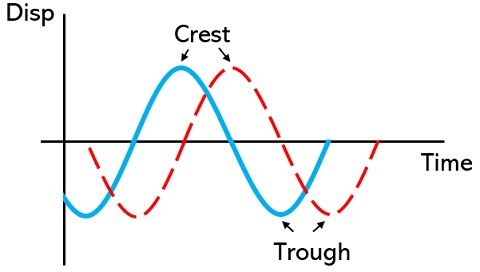Both stationary and progressive waves are the two categories in which wave is classified. The significant difference between stationary and progressive waves is noted on the basis of the energy constituent of the waves. In a stationary wave, no significant energy transfer is noticed, as the energy is confined within the medium. On the contrary, in progressive waves, energy is transferred among the molecules to reach a specific position.
What is a Wave?
A wave is regarded as a disturbance that has propagating ability through a medium without transferring the matter. More simply, we can say, the oscillation of disturbance results in a wave. Basically, the pattern obtained without any specific flow of matter is known as a wave. The transmission of the signal through waves is the base of communication systems.
Content: Stationary Vs Progressive Wave
Comparison Chart
| Basis for Comparison | Stationary Wave | Progressive Wave |
|---|---|---|
| Also called | Standing wave | Travelling wave |
| Basic | Energy is confined within the medium. | The transfer of energy from a location to another within the medium takes place. |
| Molecular vibration | Each particle of the wave exhibits different vibration at same instant of time | Each particle of the wave possesses similar vibration at different instant of time. |
| Amplitude characteristic of particles | Different | Same |
| Motion | Not transferable among the particles. | Easily transferred among the particles. |
| Velocity at mean position | All particles have their own maximum velocity. | All particles have similar maximum velocity. |
| Crests and Troughs | The crests and trough of the waveform appear and disappear at the initial position. | The crests and troughs of the waveform move in the forward direction. |
| Wavelength | Double the distance present between 2 consecutive nodes or anti-nodes. | The distance between point of similar phase at the similar time instant. |
Definition of Stationary Wave
Stationary waves or standing waves are the waves that possess vertical oscillating movement but do not undergo forward motion in a horizontal direction. It is the result of the superposition of two identical waves of the same amplitude and frequency that are propagating in the opposite direction.
Stationary wave generates vibration pattern within the medium thus energy is confined within it. It never appears to get traveled as the nearby points of the wave are of similar phase and so the energy is not transferred from one point to another.
Here all the molecules oscillate with their own specific velocity and thus the energy is not transferred through the vibration and so is confined within the medium.
Definition of Progressive Wave
A progressive or traveling wave is the one that allows propagation of energy through the medium as the wave continuously travels in one direction where the amplitude is kept constant. Basically, the molecules in the progressive wave transfer their oscillating energy in the forward direction. This leads to the propagation of energy from one point to another through the medium.
Here the particles of the wave are under motion in a continuous manner with similar maximum propagating velocity. These are of two types: longitudinal waves and transverse waves.
Key Differences Between Stationary and Progressive Waves
- In the case of a stationary wave, the energy is not propagated onwards because each particle possesses its own characteristic vibration. But in a progressive wave, the reason for energy being transmitted from one point to another is the transfer of vibration within the molecules of the wave.
- The particles of the stationary waves, that are present at the node are completely at rest while others rest for a very short time span. As against, all the particles of progressive waves are in continuous motion and thus do not rest permanently.
- Some specific velocity is associated with each particle and during motion, at the mean position, the particles attain their maximum velocity simultaneously in standing wave. While in the case of a progressive wave, all the wave particles move with the same maximum velocity at the mean position.
- In a standing wave, the motion of the particles is non- transferrable but in a progressive wave, the motion is easily transferred to the particles in the forward direction.
- For stationary waves, the energy is confined within the medium while progressive wave permits propagation of energy through the medium.
- Stationary waves do not undergo forward motion and due to this its crests and troughs blink at the initial position. While this is not the case for progressive wave because the wave undergoes forward motion and thus the crests and troughs are also in motion.
- In a stationary wave, the amplitude of each particle is 0 at the node and maximal at the antinode thus is different. However, in the progressive wave, the amplitude of each particle is the same but there is significant variation in phase.
Conclusion
So, the above discussion concludes, the stationary and progressive waves are different waves with their own characteristics. The progressive waves possess traveling nature thus is also known as a traveling wave. While the stationary wave is the resultant wave of superposition of two traveling waves of similar amplitude and frequency that are traveling in opposite directions.


